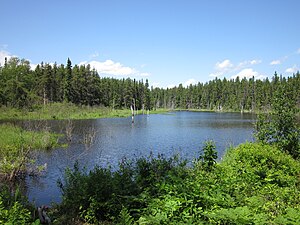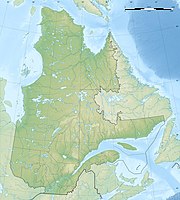Parc national de la Pointe-Taillon
|
Parc national de la Pointe-Taillon
|
||
| location | Quebec , Canada | |
| surface | 92.2 km² | |
| WDPA ID | 66592 | |
| Geographical location | 48 ° 42 ′ N , 71 ° 58 ′ W | |
|
|
||
| Setup date | 1985 | |
| administration | Parcs Québec, SEPAQ | |
The Parc national de la Pointe-Taillon is one of the national parks in the Canadian province of Québec . There, however , a parc national corresponds to what a provincial park is in the other provinces and territories . The park is operated by Sépaq ( French Société des établissements de plein air du Québec or English Society of outdoor recreation establishments of Quebec ).
The task of the 92.2 km² park, which was established in 1985 in the south of the province north of the St. Lawrence River, is to protect and represent the eponymous Fast Island and the extensive moor between the lake and the Péribonka River . The park is about 30 km north of Alma near the village of Saint-Henri-de-Taillon on the banks of Lac Saint-Jean .
history
The flat region was formed by a post-glacial delta that emerged from the massive, melting ice masses that covered the area until the end of the last ice age. The elongated sand island Pointe Taillon was created around 5000 to 3000 BC. Chr.
In 1990 a first exploration was undertaken on the northern edge of the Pointe Taillon, during which artefacts of the indigenous peoples were discovered, who have probably used the place for fishing for millennia.
Historically known as Pointe Savane, the area was named in honor of Louis-Olivier Taillon , who served as Prime Minister of Québec from January 25-29, 1887, and December 16, 1892 to May 11, 1896. The moor was opened for settlement from 1890 to 1930, and in 1925 the town of Bienheureuse-Jeanne-D'Arc had 307 inhabitants. The largest agricultural operation was L'île Bouliane with up to 125 employees. In the so-called tragedy on Lac Saint-Jean in 1926 and 1928, a dam caused a huge flood that flooded large parts of the agricultural land. Alcan, now Rio Tinto Alcan, bought the area. After that, a decade-long dispute over reparation ensued. In 1977 the government bought the land and in 1985 a park was created there. In 2007 the minister responsible announced that the islands in the lake, an area of around 3 km², should be added to the park. The park is not accessed by any road, but offers cycling, canoeing and hiking routes and 16 km of beaches.
The artificial raising of the water level of Lac Saint-Jean creates severe erosion problems in the rock-poor landscape to this day; the dam on the Péribonka exacerbates these problems, as no more sediments have been brought in since the 1950s.
Flora and fauna
Numerous orchids grow in the boggy terrain, including Arethusa bulbosa , Calopogon tuberosus and Pogonia ophioglossoides . Rare plants also include Xiris montana from the Xyridaceae family or Arceuthobium pusillum from the genus of dwarf mistletoe .
A small, stable population of around 24 elk was found in 1998 and 2004 by flying overhead; she also hikes outside the park and has been involved in road accidents twice.
In terms of insects, the dragonfly species Leucorrhinia frigida , Nannothemis bella and Somatochlora incurvata from the falcon dragonfly family should be emphasized, as well as the rare butterfly species Papaipema appassionata . However, the fauna has not yet been scientifically researched.
Sandhill cranes have been observed since 2000 .
See also
literature
- The research scientifique dans les Parcs nationaux québécois. Priorités et potentiels de recherche , published by Parcs Québec and Sépaq, undated, pp. 151–156.
- C. Dussault: Inventaire de l'orignal (Alces alces) etproblemématique des accidents routiers dans le secteur du parc national de la Pointe-Taillon , published by the Société de la faune et des parcs du Québec, Direction de l'aménagement de la faune du Saguenay – Lac-Saint-Jean, 2004.
Web links
- Parc national de la Pointe-Taillon , Sépaq (French)



